A DBA tends to be the "person of last resort" in prioritizing and solving issues as they come in. The Oracle DBA has been in a constant state of transformation for decades. Sometimes, it's a job that directly works with Applications like financials; other times, custom applications or an APEX app for a phone takes the front seat, but administration & security never gets to rest. 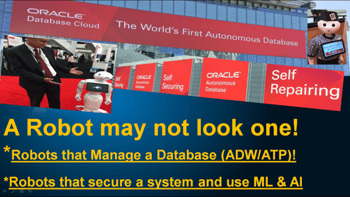 The Autonomous Database has offered to give the DBA a digital twin to help alleviate the demand for less important or less used databases (note the image on ATP= Autonomous Transaction Processing that took all of 2 minutes to create the database). A training application may not be as important as a stock market application for a trading company. Yet, a training application that trains an employee at just the right time to fix a valve at a refinery before it breaks (using prescriptive analytics) may be crucially important to an oil company.
The Autonomous Database has offered to give the DBA a digital twin to help alleviate the demand for less important or less used databases (note the image on ATP= Autonomous Transaction Processing that took all of 2 minutes to create the database). A training application may not be as important as a stock market application for a trading company. Yet, a training application that trains an employee at just the right time to fix a valve at a refinery before it breaks (using prescriptive analytics) may be crucially important to an oil company.
Still, DBAs are generally overworked & underutilized, as I mentioned in a recent Forbes article. DBAs are underutilized in the world of Machine Learning (ML), where they can help provide the data needed for Data Scientists. 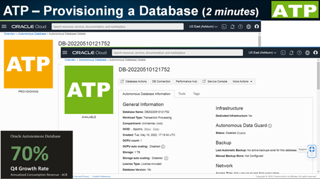 One paper shows that data preparation represents 80% of Machine Learning projects, while Data Science is only around 20%. Yet, 80% of ML projects fail. While there are many reasons for failures, not having a good DBA is at the top of the list, and not having a DBA on the project is another (although usual reasons also include: bad data / not enough data / missing data...etc.). With the advent of ML & additional AI, such as robotics, VR (virtual reality), AR (augmented reality), GPS integration, etc., the DBA is more crucial than ever.
One paper shows that data preparation represents 80% of Machine Learning projects, while Data Science is only around 20%. Yet, 80% of ML projects fail. While there are many reasons for failures, not having a good DBA is at the top of the list, and not having a DBA on the project is another (although usual reasons also include: bad data / not enough data / missing data...etc.). With the advent of ML & additional AI, such as robotics, VR (virtual reality), AR (augmented reality), GPS integration, etc., the DBA is more crucial than ever.
We'll discuss some new choices for DBAs to consider:
- Assist in Machine Learning to help the Data Scientist get better data (ML DBA)
- Dive into Machine Learning & start to leverage algorithms for the business (Data Scientist)
- Stay an administration DBA (DBA)
- Integrate things like VR/AR/GPS to enhance sales, security, or delivery (Emerging Technology)
- Integrate Robotics (Build the future)
- Move into Management of one or all of the above (Manage the team that does the above tasks)
Become the Machine Learning DBA or Data Scientist
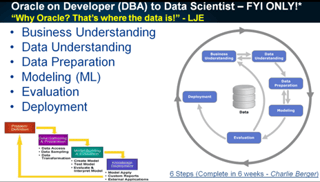 Much of the job in Machine Learning (ML) is all about the data: moving, manipulating, augmenting, deleting duplicates, connecting, combining, and evaluating. As a DBA, you may have done this for over a decade, and it is probably your best skill. Data Scientists are often lost when it comes to the harder parts of preparing the data set. You will either be a key member of the team or add data science to your skills to be the team leader of that next ML project. The project starts with a well-formulated business problem: Who are our best customers by revenue, profit, repeat business, and referrals?
Much of the job in Machine Learning (ML) is all about the data: moving, manipulating, augmenting, deleting duplicates, connecting, combining, and evaluating. As a DBA, you may have done this for over a decade, and it is probably your best skill. Data Scientists are often lost when it comes to the harder parts of preparing the data set. You will either be a key member of the team or add data science to your skills to be the team leader of that next ML project. The project starts with a well-formulated business problem: Who are our best customers by revenue, profit, repeat business, and referrals? 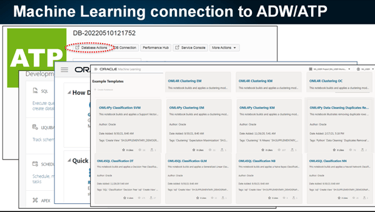 Next, it's all about understanding & preparing the data: deleting bad data, combining good data sources, filling in missing data, finding big data that might fit, and getting data from other cloud providers. Now we can build and train a model (using 60% of the data) with function that calls for an algorithm (some math that does something for us). Let's use a function that classifies our good & bad customers using an algorithm (support vector machine). Then we'll use the other 40% of the data to test our model and perhaps pick a better (or faster) algorithm.
Next, it's all about understanding & preparing the data: deleting bad data, combining good data sources, filling in missing data, finding big data that might fit, and getting data from other cloud providers. Now we can build and train a model (using 60% of the data) with function that calls for an algorithm (some math that does something for us). Let's use a function that classifies our good & bad customers using an algorithm (support vector machine). Then we'll use the other 40% of the data to test our model and perhaps pick a better (or faster) algorithm.
When you use Machine Learning notebooks in Oracle, it has examples of either SQL & PL/SQL, Python, or R. You choose the language you want to use. There are more examples of using each algorithm for a business problem than you'll need for a very long time. As you work your way through the different algorithm examples, you'll quickly see that you don't need to learn all of them at once. 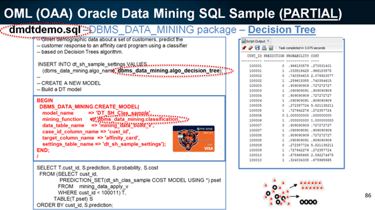 You just need to find the one that solves the problem that's important to your company. Perhaps it's the classification of good and bad customers. After that, you may want to find the attributes that make up a good or bad customer. Then you might want to go out to big data and find more customers like your best ones. The dmdtdemo.sql example is just one that Oracle has to show how easy it is to classify (the function you're performing) potential customers into two groups (either a customer that will buy a logo credit card with their favorite team or won't buy one). It uses an algorithm (decision tree) and has a SQL query to list the results for the salesperson who will focus on the best potential clients. Okay, you did have to write 15 minutes of SQL code to create the model & query the data, and you had to learn what function/algorithm would do this for you. But hey, now you're a data scientist (not really), and maybe they'll have to double your salary. Is this where you want to take your career - no more running/fixing backups in the middle of the night and getting calls day & night for half the pay (that's tough to leave behind)? You'll have to do pizza meet-ups at 4 pm and share successes with your latest hour of coding that found 20 new clients (that you've classified as good potentials) that will bring your company the next $1M deals. Oh yeah, the hard part was finding the data to teach your model (being a DBA was the key).
You just need to find the one that solves the problem that's important to your company. Perhaps it's the classification of good and bad customers. After that, you may want to find the attributes that make up a good or bad customer. Then you might want to go out to big data and find more customers like your best ones. The dmdtdemo.sql example is just one that Oracle has to show how easy it is to classify (the function you're performing) potential customers into two groups (either a customer that will buy a logo credit card with their favorite team or won't buy one). It uses an algorithm (decision tree) and has a SQL query to list the results for the salesperson who will focus on the best potential clients. Okay, you did have to write 15 minutes of SQL code to create the model & query the data, and you had to learn what function/algorithm would do this for you. But hey, now you're a data scientist (not really), and maybe they'll have to double your salary. Is this where you want to take your career - no more running/fixing backups in the middle of the night and getting calls day & night for half the pay (that's tough to leave behind)? You'll have to do pizza meet-ups at 4 pm and share successes with your latest hour of coding that found 20 new clients (that you've classified as good potentials) that will bring your company the next $1M deals. Oh yeah, the hard part was finding the data to teach your model (being a DBA was the key).
Stay the DBA & the Job You Have Now
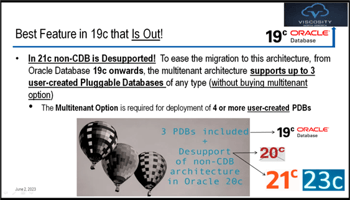 Maybe retirement is not that far away. You've migrated to 19c, and the next version, 23c, maybe the last one you need to support. First, you need to train your digital twin (autonomous database) to manage all of those easy databases that nobody has time to manage. That's 2 minutes to create the database, then migrate the data (shouldn't be much since these are databases that nobody is taking care of), then get all the patches (oh, that's right, you’re using autonomous database - it does all of that for you). Next, start ensuring you're using all the best features in the database that really matter (the one they pay you to keep the system up 24/7 since it runs the business). Maybe you just enjoy being the DBA. As the problem solver of last resort, you often get to fix the latest impossible problem. It can be performance, security, integration, recoverability, availability, business sense, or just experience. You may just want to stay the DBA!
Maybe retirement is not that far away. You've migrated to 19c, and the next version, 23c, maybe the last one you need to support. First, you need to train your digital twin (autonomous database) to manage all of those easy databases that nobody has time to manage. That's 2 minutes to create the database, then migrate the data (shouldn't be much since these are databases that nobody is taking care of), then get all the patches (oh, that's right, you’re using autonomous database - it does all of that for you). Next, start ensuring you're using all the best features in the database that really matter (the one they pay you to keep the system up 24/7 since it runs the business). Maybe you just enjoy being the DBA. As the problem solver of last resort, you often get to fix the latest impossible problem. It can be performance, security, integration, recoverability, availability, business sense, or just experience. You may just want to stay the DBA!
Some features you should be considering; use the best features that were in:
- Key 12c Features to Leverage: Pluggable Databases and In-Memory Column Store
- Key 18c Features to Try: Snapshot Carousel, PDB Switchover, & In-Memory External Tables
- Key 19c Features to Try (current long-term version): 3 free PDBs, ADW/ATP, SQL Quarantine, Persistent Memory, Sharded RAC, AJD (Autonomous JSON Database) & Automatic Indexes. There are also key features from earlier versions that you should leverage in 19c/23c. You should upgrade to 19c soon if you're not there now. We can help!
- Key 21c Features to Try: JavaScript in the DB, AutoML (Auto Machine Learning), OML4Py, SQL Macros, Persistent Memory, Blockchain Tables, Auto In-Memory Management, Hybrid In-Memory Scans, AutoUpgrade, Active Data Guard with Standby DB Result Cache
- Key 23c Features to Play with (see my last 23c blog for much more on this): True Cache, Priority Transactions, Auto SQL Repair, JavaScript in the Database, Read-Only per-PDB standbys, Schema-Level Privileges, and a new Developer Role. While 23c has over 300 new features, don't forget that 21c brought 200 features to light. While some of these may be back-ported to 19c, you certainly want to be aware of some of the best ones.
Stay tuned for Part II!
References:
- DBAs Next Great Job, (presentation), Rich Niemiec
- Larry Ellison Keynote at CloudWorld
- Oracle 23c; Oracle CloudWorld, Andrew Mendelsohn
- Oracle 23c; Oracle CloudWorld, Jenny Tsai-Smith & Dominic Giles
- Preparing for Oracle 23c, Rich Niemiec
- https://blogs.oracle.com/authors/mark-hornick
- Oracle12c Release 2 Performance Tuning Tips & Techniques; Richard J. Niemiec; Oracle Press
- viscosityna.com, www.oracle.com, & technet.oracle.com
- All companies and product names are trademarks or registered trademarks of the respective owners
- Rich Niemiec ©2023. This document cannot be reproduced without expressed written consent from Rich Niemiec or Viscosity NA, but may be reproduced or copied for article, presentation, and conference use by the author.
- Neither Viscosity nor the author guarantees this document to be error-free. Please provide comments/questions to richniemiec@gmail.com – niemiec@viscosityna.com; I am always looking to improve!

-2.png)

SUBMIT YOUR COMMENT